Benin Photography Tour Report 2022
8 February 2022







































































































































































A Borgu Fulani woman nurses her baby in remote Benin (image by Inger Vandyke)

A Koku dancer pauses between acts of his ceremony (image by Inger Vandyke)

Ceremonial legbas outside of an Otamari tata home (image by Inger Vandyke)

A young Sahoué boy holding a horse tail divinity used during Gambada, the voodoo celebration of love (image by Inger Vandyke)

A beautiful Otamari woman dancer wearing her antelope hat (image by Inger Vandyke)

Just a typical and beautiful scene in Ganvié, Africa's largest floating village (image by Inger Vandyke)

Galloping through the streets, a Batonu horseman puts on a display for our group (image by Inger Vandyke)

Modern day Holi people still practice facial scarification as part of their culture (image by Inger Vandyke)

Tofinu women paddling their produce-laden pirogue to the daily floating market in Ganvié (image by Inger Vandyke)

Young Otamari women dressed to perform the male and female initiation dances of Dikpantri (men) and Dikountri (women) in the Atacora mountains of northern Benin (image by Inger Vandyke)

A young boy sifts through the mud looking for worms to use as bait for his fishing foray (image by Inger Vandyke)

Street life in Benin (image by Inger Vandyke)

The crazy dancing dog of Guélédé (image by Inger Vandyke)

Shango priests place their hands on a skull to assist with determining the fate of a guilty criminal (image by Inger Vandyke)

The traditional scarification of Otamari people in Benin is delicate and beautiful (image by Inger Vandyke)

A traditional Fulani village in northern Benin. They are always so clean and well constructed! (image by Inger Vandyke)

Portrait of a beautiful Holi girl in her home (image by Inger Vandyke)

A young Otamari boy plays in the ceremonial legbas outside his Tata home (image by Inger Vandyke)

This fabulous Egungun with his beautiful dress and aggressive moves was a favourite dancer on our trip (image by Inger Vandyke)

A collection of twin dolls, each representing a deceased twin child of its parents (image by Inger Vandyke)

A Koku master of ceremonies sits in a circle of raffia skirts that forms the centrepiece of a dance arena (image by Inger Vandyke)

Dikountri dancers in Otamari culture are so very beautiful, even in monochrome! (image by Inger Vandyke)

The highest Shango priest of Benin, holding a sacrificial chicken during a judicial hearing (image by Inger Vandyke)

Portrait of a Batonu Horseman (image by Inger Vandyke)

The wild dancing dog at a Guélédé ceremony. He is always the most flamboyant final act of this famous dance! (image by Inger Vandyke)

A little Otamari boy wears the antelope hat of his mother after a ceremony (image by Inger Vandyke)

A Shango priest holds the skulls of the guilty during a ceremony where a person is heard after committing a crime (image by Inger Vandyke)

Dancing horses in the dust in remote Benin (image by Inger Vandyke)

Warming up for the ceremony a wild Guélédé masked dancer makes his way down an alley to the dance arena (image by Inger Vandyke)

Portrait of a heavily tattooed Fulani woman we met in a local market of northern Benin (image by Inger Vandyke)

Zangbetos are always accompanied by guardians who keep them in line and who try to stop them from running into each other! (image by Inger Vandyke)

Spending time with Taneka elders in the remote Atacora mountains is always a magical part of our tour (image by Inger Vandyke)

Whitebait for sale at the daily fish market in Cotonou (image by Inger Vandyke)

A Batonu Horseman dressed in lace (image by Inger Vandyke)

Portrait of a Fulani woman in a remote market of Benin. To find women wearing this dress is extremely difficult so meeting her on our tour was a real highlight (image by Inger Vandyke)

Benin is one of Africa's friendliest countries. Warm smiles are literally everywhere! (image by Inger Vandyke)

Otamari women dancing the Shimo, or spiritual separation of twins in their culture (image by Inger Vandyke)

Mid-flight! A Koku dancer emerges from trance to join the ceremony (image by Inger Vandyke)

Hand made pots for sale at a market (image by Inger Vandyke)

Portrait of the main Voodoo priestess who oversees ceremonies at Dankoli Fetish, the most prominent voodoo shrine on earth (image by Inger Vandyke)

A giggling Otamari girl on the roof of her Tata in northern Benin (image by Inger Vandyke)

An Egungun out and about (image by Inger Vandyke)

A large masked dancer in the celebration of Guélédé (image by Inger Vandyke)

An aerial shot of a Zangbeto with its guardian. Drone image shot under strict permission during our 2022 tour (image by Inger Vandyke)

A twirling Egungun whose mask was looking towards the sky (image by Inger Vandyke)

Raffia detail of a Zangbeto costume (image by Inger Vandyke)

A show of strength in young Otamari men, wrestling is a part of a traditional ceremony called Tepeinji (image by Inger Vandyke)

A devotee sits inside a Voodoo temple of power in Benin (image by Inger Vandyke)

Even young children trance dance at Gambada (image by Inger Vandyke)

A young girl proudly sits on her dad's fishing pirogue in coastal Benin (image by Inger Vandyke)

The Fulani people make up one of the largest ethnic groups across the Sahara and Sahel in Africa but they are split into sub-cultures including the Borgu (Fulfulde) Fulanis with their incredible facial tattoos (image by Inger Vandyke)

The last children standing in the remains of their burned out fishing villages in coastal Benin. These have been destroyed to make way for tourist resorts (image by Inger Vandyke)

Ganvié child (image by Inger Vandyke)

A Beninese woman offloads a water cannister from her pirogue in remote Benin (image by Inger Vandyke)

The spectacular ceremony of Shango acts as a voodoo judicial hearing in Benin (image by Inger Vandyke)
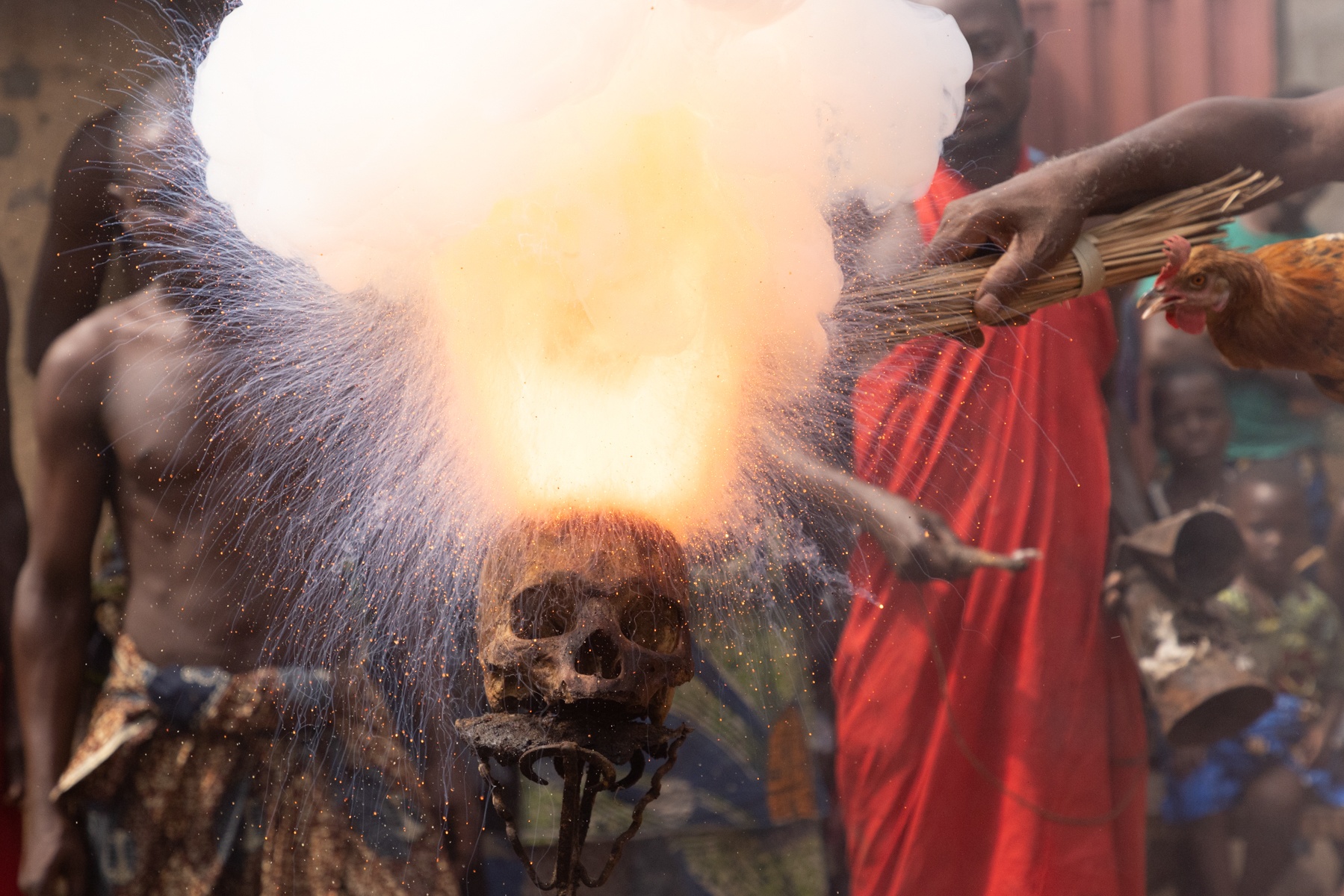
An exploding skull during a Shango judicial hearing! (image by Inger Vandyke)

Portrait of a Taneka traditional healer smoking his long pipe outside his home in the foothills of the Atacora mountains (image by Inger Vandyke)

Filleting fish is usually done by women after a catch is brought in (image by Inger Vandyke)

A rare opportunity to witness a female initiation ceremony in Fulani people (image by Inger Vandyke)

Dancing twins in the ceremony of Guélédé (image by Inger Vandyke)

A young boy mends his fishing nets in a remote fishing village near the border of Benin and Nigeria (image by Inger Vandyke)

Beautiful Mahé child (image by Inger Vandyke)

Portrait of Marc. He is the youngest of many generations of python handlers at the python temple in Ouidah (image by Inger Vandyke)

A Beninese fisherman sits in the burned ruins of his village on the coastline of Benin. Sadly these charismatic villages are being destroyed to make way for tourist resorts (image by Inger Vandyke)

In voodoo, horns are often used to determine justice (image by Inger Vandyke)

Beautiful Sahoué girl in remote Benin (image by Inger Vandyke)

The fine scarification of Otamari people also adorns women (image by Inger Vandyke)

Tremendous Koku scarification in remote Benin (image by Inger Vandyke)

Traditional hand tattoos in Fulani people (image by Inger Vandyke)

A group of Shango priests make a judgement of guilt during a ceremony (image by Inger Vandyke)

Lively Waaba dancing during a ceremony that celebrates young women and girls (image by Inger Vandyke)

Super fine fishing nets used to catch fish on the freshwater lakes spanning the border between Nigeria and Benin (image by Inger Vandyke)

Shango is the god of thunder and lightning in voodoo and he is consulted through a burning skull when a crime has been committed (image by Inger Vandyke)

Portrait of a Fulani 'queen' in remote Benin (image by Inger Vandyke)

A young Tofinu girl paddling her pirogue around Ganvié, the Venice of West Africa (image by Inger Vandyke)

A Tofinu man fishing with his son from their pirogue on Lake Nokué (image by Inger Vandyke)

Young Otamari boy helping to carry ceremony items at sunset (image by Inger Vandyke)

Walking home from the ceremony (image by Inger Vandyke)

A fisherman loads his nets on his hand-carved wooden pirogue in remote Benin (image by Inger Vandyke)

A human skull acts as a centrepiece for a Shango judicial ceremony in voodoo (image by Inger Vandyke)

Portrait of a Batonu horseman in full dress (image by Inger Vandyke)

Egunguns are depicted in street art across Benin (image by Inger Vandyke)

Beautiful twin girls enjoy a swim in a remote lake on the border of Benin and Nigeria (image by Inger Vandyke)

Golden reflections on Lake Nokué (image by Inger Vandyke)

A flipped Zangbeto reveals a tiny 'spirit human' inside a chalk circle on the ground (image by Inger Vandyke)

A young fisherman gathers his nets before going to fish on remote lake near the border of Benin and Nigeria (image by Inger Vandyke)

Covered in Kaolin and yellow palm oil a Koku dancer almost has a golden appearance (image by Inger Vandyke)

Portrait of a young boy with his goat in Benin (image by Inger Vandyke)

During our private photo shoot with Egungun dancers we had a chance to really appreciate the beauty of their costumes (image by Inger Vandyke)

Offerings of alcohol are offered to guests attending a Shango ceremony (image by Inger Vandyke)

A monkey skull adorns the dress of a Zangbeto masked dancer in remote Benin (image by Inger Vandyke)

A minder keeps his Egunguns in check. These masked dancers are the living embodiment of the ancestors on earth and they strike terror into onlookers (image by Inger Vandyke)

What a difference a year makes. A drone shot of the burned fishing villages that once adorned a stretch of coast between Ouidah and Porto Novo (image by Inger Vandyke)

Taking fresh drinking water to Ganvié, the Venice of Africa (image by Inger Vandyke)

A twirling Zangbeto photographed by drone under strict permission on our 2022 tour (image by Inger Vandyke)

One of the entranced dancers of Gambada enters centre stage (image by Inger Vandyke)
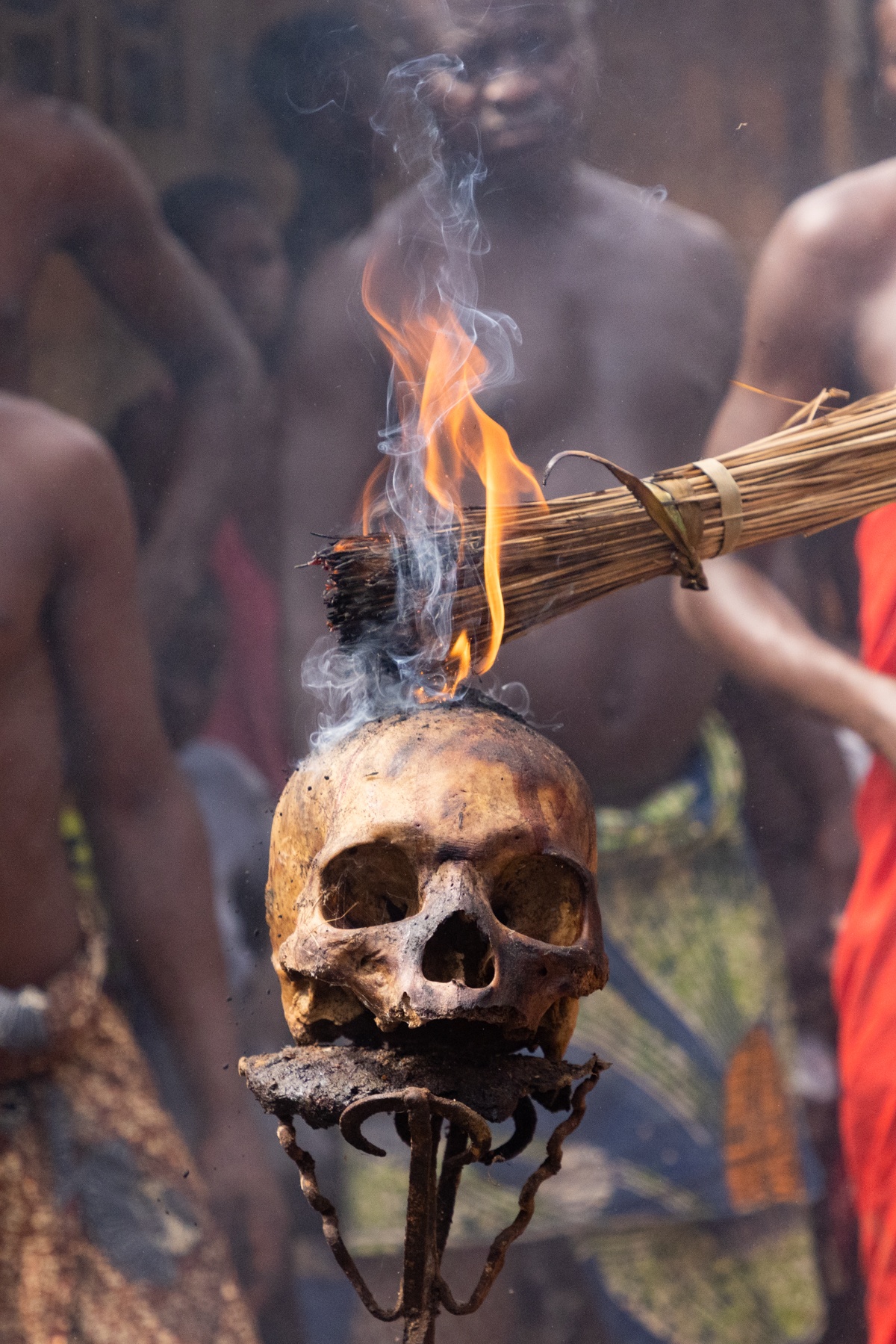
Lighting the gunpowder on a human skull during a Shango ceremony (image by Inger Vandyke)

The wild judiciary ceremony of Shango in Benin (image by Inger Vandyke)

The stunning traditional body tattoos of Holi people. This practice has now been abandoned after Christian missionaries forced it to stop (image by Inger Vandyke)

Pirogue parking lot in Lake Nokué (image by Inger Vandyke)

A local woman paddling her pirogue through the 'back streets' of Ganvié (image by Inger Vandyke)

The Batonu Horsemen of Benin are mostly descendents of aristocracy from the kingdom of Nikki in Nigeria (image by Inger Vandyke)

Assistants help the dancing dog of Guélédé to take a break between performances (image by Inger Vandyke)

An elderly Mahe woman takes a break from her dance of Gelede, a ceremony of the feminine divinity in Yoruba culture (image by Inger Vandyke)

Covered in Kaolin, a Gambada dancer in trance (image by Inger Vandyke)

When they are not riding, the Batonu horsemen of Benin dismount and dance on foot (image by Inger Vandyke)

The skulls of three criminals at a Shango ceremony (image by Inger Vandyke)

Aerial view of Ganvié one late afternoon during our tour (image by Inger Vandyke)

A young Mahé girl sitting in the root span of a large fig tree in her village (image by Inger Vandyke)

Tomatoes, chillies and onions for sale at the market in Porto Novo (image by Inger Vandyke)

Masked dancers in Africa are nearly always guided by a person to perform (image by Inger Vandyke)

Detail of one of the Guélédé masks (image by Inger Vandyke)

A Shango priest holding a sacred human skull (image by Inger Vandyke)

A little Otamari boy in the earthy doorway of his family's tata, or clay home (image by Inger Vandyke)

A Holi woman holds yellow palm oil seeds in her hands. Palm Oil is an ingredient used in traditional foods and it is also used in ceremonies as offerings (image by Inger Vandyke)

Aerial shot of a Zangbeto, its guardian and 'spirit human'. Shot under strict permission by drone on our 2022 tour (image by Inger Vandyke)

A group of Batonu horse riders in Benin. Horsemanship across Africa is a lesser understood part of African cultures. On our tour you plunge headlong into their world and get to meet them behind the scenes (image by Inger Vandyke)
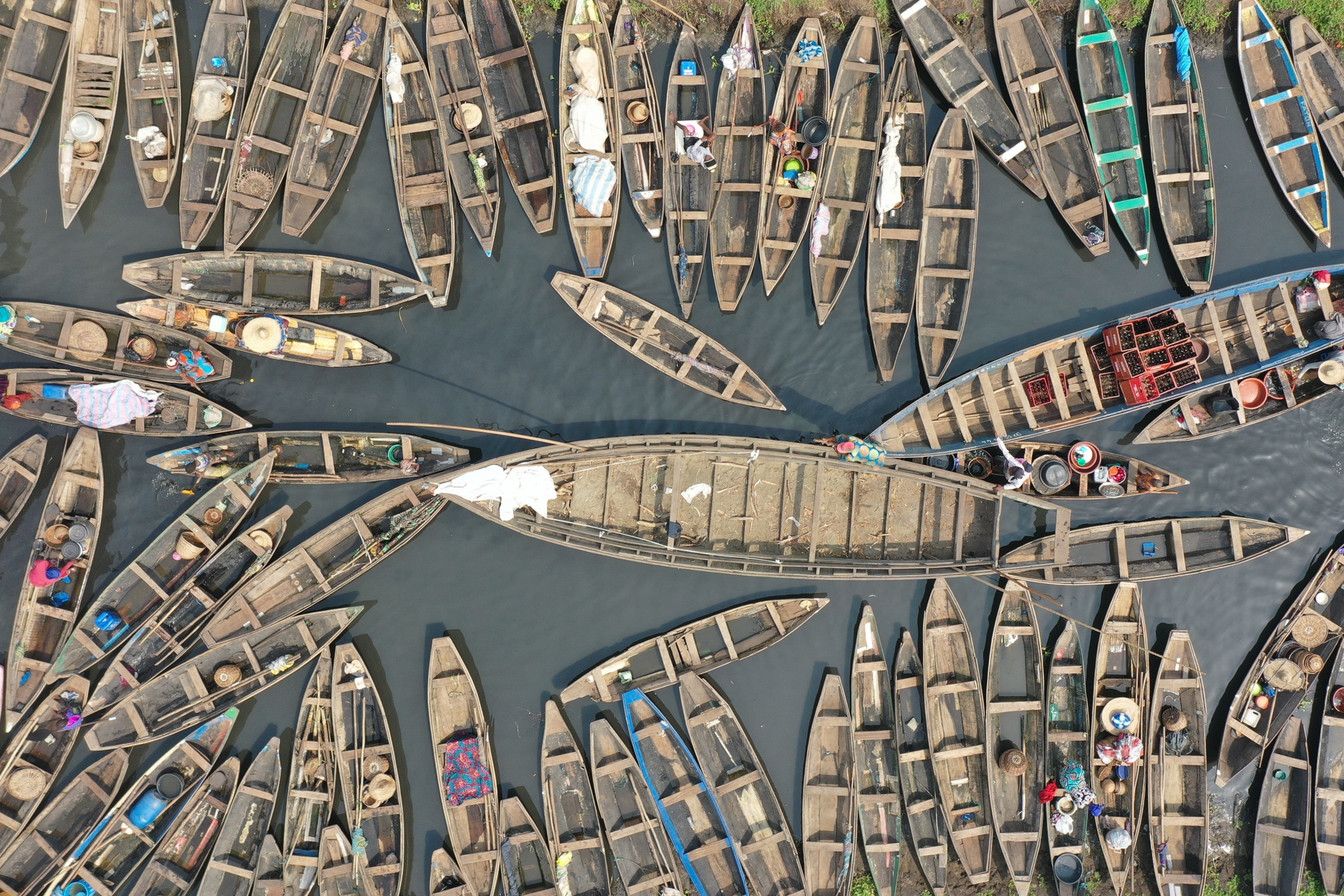
Rush hour in Ganvié, the 'Venice of Africa' (image by Inger Vandyke)

A beautiful Waaba child dressed up to dance (image by Inger Vandyke)

A beautiful Tofinu woman wearing a traditional hat in the stilted village of Ganvié (image by Inger Vandyke)

A protective amulet worn by the highest Shango priest in Benin (image by Inger Vandyke)

Aerial view of Tofinu women plying their seafood wares at the daily market near Cotonou (image by Inger Vandyke)

A Tofinu lady poles her way through the water hyacinths of Lake Nokué. Traditionally the Tofinu are known for their beautiful tattoos, as can be seen here, adorning this lady's legs (image by Inger Vandyke)

A Koku dancer performs in the heat and dust of West Africa (image by Inger Vandyke)

A bundle of Otamari women's skirts (image by Inger Vandyke)

A group of Sahoué emerge from a temple to dance the Gambada, the voodoo celebration of love (image by Inger Vandyke)

Across Africa, Fulani people treat facial tattoos as a sign of beauty. Traditionally they will tattoo their bottom lips in what is called 'Tchoodi' (image by Inger Vandyke)

The beautiful detail of Egungun costume (image by Inger Vandyke)

A masked dancer carrying a cooking pot on his head at a Guélédé ceremony (image by Inger Vandyke)

Portrait of a Dikpantri male dancer in the Otamari region of northern Benin (image by Inger Vandyke)

A masked Guélédé dancer performing a dance of pregnancy in this celebration of the feminine divinity in Yoruba culture (image by Inger Vandyke)

A random Egungun we met on a road in remote Benin (image by Inger Vandyke)

Zangbetos are the night guardians of voodoo. Unique to Benin they are highly revered and they spin with the help of a 'spirit human' (image by Inger Vandyke)

An elderly Holi woman smiling and showing off her beautiful tattoo decorations (image by Inger Vandyke)

Portrait of an Otamari musician playing his flute in front of a hollow Baobab tree in the Atacora mountains (image by Inger Vandyke)

A Koku dancer rams a knife down his own throat to show his strength and power in Voodoo (image by Inger Vandyke)

Priests offer blessings to a voodoo legba inside the Gambada temple of love (image by Inger Vandyke)

A beautiful Dikountri dancer on the roof of a traditional Tata, or Otamari home, in northern Benin (image by Inger Vandyke)

Mahe children giggling and hanging out while they wait for a ceremony (image by Inger Vandyke)

Koku dancers gyrating with their fantastic raffia skirts on the way to a ceremony (image by Inger Vandyke)

A Batonu horseman dancing his horse through the streets (image by Inger Vandyke)

A group of Batonu horsemen in the stables before taking their horses out to race and dance (image by Inger Vandyke)

The highest Shango priest in Benin holds a skull of a guilty criminal (image by Inger Vandyke)

Aerial view of Egungun dancers, shot on a drone with strict permission of the dance organisers (image by Inger Vandyke)

Portrait of a Shimo dancer inside an earthly Tata home of the Otamari people (image by Inger Vandyke)

Portrait of a Shango priest at a judicial ceremony (image by Inger Vandyke)

Wild Gambada dancers in trance in remote Benin (image by Inger Vandyke)

Descendent from the Kingdom of Nikki in Nigeria, the Batonu Horsemen are a part of myth and legend in this part of remote Africa (image by Inger Vandyke)

Portrait of Marc. He is the youngest of many generations of python handlers at the Python Temple of Ouidah (image by Inger Vandyke)

The children of Ganvié grow up surrounded by water and at a young age they are experts at paddling pirogues around their village (image by Inger Vandyke)

A Tipeinji warrior on the top of an Otamari tata in the Atacora mountains of northern Benin (image by Inger Vandyke)

Decoration of one of the beautiful Batonu horses (image by Inger Vandyke)

Portrait of a beautiful Fulani girl in remote Benin. Young girls are often dressed up in stunning jewellery in this culture. The Royal Blue colour is symbolic of Borgu Fulanis (image by Inger Vandyke)

Koku. The voodoo spirit of power (image by Inger Vandyke)

Portrait of a Shango priestess (image by Inger Vandyke)

A beautiful Otamari woman dances at Shimo, the ceremony representing the spiritual separation of twins (image by Inger Vandyke)

Beautiful Waaba women take a break from dancing in northern Benin (image by Inger Vandyke)

A Gambada priestess on her way to a ceremony of the same name (image by Inger Vandyke)

An Egungun with his guardian during our private photo shoot (image by Inger Vandyke)

Egunguns look even more beautiful from the air. Image shot under strict permission of the dance organisers during our tour (image by Inger Vandyke)

During a private audience with the King of Voodoo, King Agassa, we asked where he would like to be photographed and he opted for a chair underneath a photo of his father (image by Inger Vandyke)

Waiting for the dance to begin (image by Inger Vandyke)

A tiny kitten hides in the corn pile on the roof of an Otamari tata (image by Inger Vandyke)

A clash of Egunguns, seen from the sky (image by Inger Vandyke)

Portrait of a beautiful young Fulani woman with spectacular facial tattoos (image by Inger Vandyke
It is early January and in the West African country of Benin, the groundswell of activity was growing in anticipation of the country’s annual voodoo festival. Established as an honour to the kaleidoscope of cultures in this fascinating it was determined that January should be the right month to hold the festival, which celebrates the religion of Voodoo and Beninese culture in all its glory. During the pandemic the festival has been curtailed to avoid large public gatherings but while the 2021 festival was very quiet, the 2022 had a bit more activity and our expert local guides swung into response by organising some more private ceremonies for our group (which are better for photography than the big festival events anyway).
Our itinerary was only supposed to visit five ceremonies and in the end we were enthralled with attendances at no less than thirteen! Some of them were utterly spectacular while others moved some of us greatly by their beauty. Combine that with meeting some incredibly highly decorated tribal people including tattooed Fulanis and Tofinu people, scarred Somba and Holi people and also some of the lesser known cultures of Benin including the Batonu horsemen, local fisherfolk in remote villages, the beautiful Waaba people of the north and the Fon and Sahoué people in the south of the country and our tour was truly an incredible journey!
Exploding heads, Athletic Dancers and Devotees of the Spirits – Our first Voodoo ceremonies!
We met in Cotonou a few days before the festival started and given the scattered arrivals of our group the early arrivers kickstarted the trip by meeting our guides and driver in a fantastic local fish restaurant in Cotonou. It was a great way to start over a few cold beers and a dinner of freshly grilled West African fish on the beach!
By the time the clock struck midnight another of our guests arrived and since our group was almost complete, we were offered an opportunity to visit two separate ceremonies to those on our itinerary. The first was a traditional judiciary ceremony of voodoo, or Shango, and the second was simply a traditional voodoo ceremony for love where the devotees attend to find a new partner or luck with love in their lives.
Shango – A Traditional Judiciary Hearing of Voodoo Religion
Our tour started with a literal bang when we travelled out to a regional centre of Benin at Bopa, around 80km from Cotonou. It was here that we joined a traditional Shango ceremony of voodoo, an act of religious judiciary that was presided over by a head Shango priest named Toffa. We arrived at a small courtyard to the rhythmic beating of drums and women singing. Entering this enclosed space we were surprised to see a group of people dancing and gyrating around a human skull propped up on a metal pole!
This fascinating ceremony is performed by the Fon people of Benin to determine if a person is guilty or not after they have committed a crime. If the perpetrator is found to have done something, he must present himself to the Shango chief to find out his punishment. If he doesn’t turn up to meet the chief it is thought he will be struck by the lightning entity of voodoo ‘Shango’. If he turns up and is found guilty then he will die!
When we arrived we sat at the side of the celebration to watch what might happen. The human skull seemed to form the centre piece of a ‘shrine’ that was gradually being added to with offerings including bones, skin, feathers and wood. The frenzy of dancing intensified and we watched as a wooden box containing three human skulls was brought out to the shrine. After this a gentle handful of gun powder was laid down at strategic points on the shrine including the propped up human skull.
We then watched as two chickens and a goat were sacrificed as offerings to Shango. For the chickens some of the spilled blood was kept and added to alcohol to be gifted to attending guests of the ceremony.
Once the sacrifices were complete the piled gunpowder was lit and small explosions happened, the most spectacular of which was the human skull which literally looked like an exploding head!
As with many other voodoo ceremonies, the blood of the sacrificed animals was then spread onto spiritual items including bones and the legba of the Shango temple. We were then offered a ‘power’ drink of the blood with alcohol which actually didn’t taste too bad! Finally we were allowed to take some portraits of Toffa and the Shango attendants before we left.What a tremendous introduction to the world of voodoo!
Leaving to enjoy lunch in a lakeside restaurant, we had a small break and enjoyed watching local fisherman catching lake fish as we sat in the shade.
Gambada – A Voodoo celebration of Love
Later that day we went out to another village named Medjrohoue where a community of Sahoué people performed a Gambada, or ceremony of love, for us.
The village name can be literally translated into ‘the village of strangers’ and when we arrived we met the head man Francois who was preparing for the ceremony. The centre piece of this ceremony was a rather odd human-like figure that was given cigarettes to smoke both before the ceremony started and during the ceremony itself! Behind it was a decorated wall mural with depictions of Francois and other symbols of voodoo including the renowned Mamiwata, the voodoo mermaid goddess of the sea. We stopped to take some photos of Francois in front of the murals and we were amused to find a local chicken had decided to shepherd her tiny chicks around the ceremonial legba. We were then invited to see inside the temple of love that was there which was fascinating in itself with a centre shrine and some seats that acted as pews. We watched Francois and another couple of gents offer cigarettes to the legbas inside.
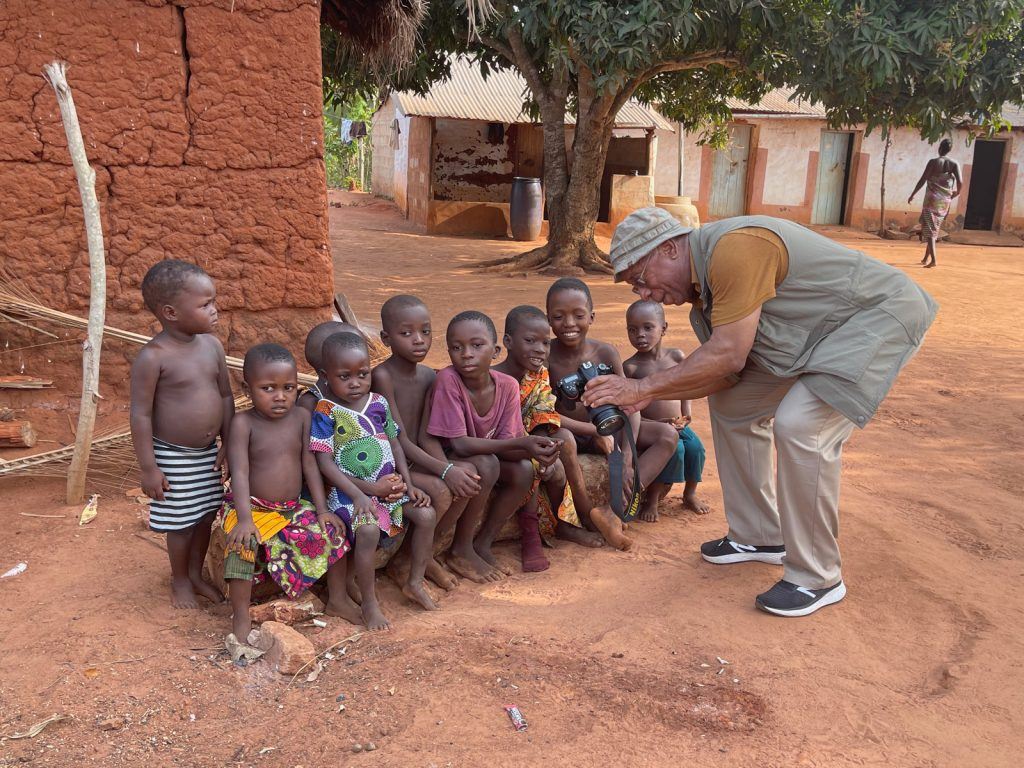
David showing a group of Beninese kids their photos during our visit to a Gambada ceremony in their village (image by Inger Vandyke)
We were then invited to take a short walk to a nearby community where we could meet the dancers preparing for the ceremony and visit another temple so we wandered a path of dusty African streets, past the trunk of an ancient and twisted, gnarled tree to find a pleasant community of Sahoué people centred around a well. Meeting the dancers there we took some photos at the temple and also at the well before we joined them in their walk around to the ceremony stage.
Once arriving there we were enthralled to witness our first of several voodoo trances, where the spirits take over a human and they are guided by non-trance people to get ready to perform. For this ceremony the dancers were covered in a white talcum powder (traditionally this would have been kaolin) and taken to the seated VIPs of the ceremony where they were blessed before they joined the dancing of the ceremony. To mark the centre point of the dance arena, elders marked out a heart using talcum powder where they placed a bottle of alcoholic spirit which was then lit and used to light cigarettes.
The dance continued until sunset and culminated in a chicken being slaughtered and then prepared by a man who was sitting on the ground under a white cloth. The chicken, like all animals sacrificed for voodoo, was later eaten.
We left hoping that the people who were in attendance and dancing would find their love and we checked into our lovely hotel on the beach at Grand Popo. What a tremendous way to start our learning and photography journey with voodoo!
An Audience with the King of Voodoo at his Palace Compound
The next morning we went off to enjoy an intimate meeting with the King Agassa, the highest figure of voodoo in Africa and a figure who is revered by over 30 million followers across the continent. En-route we saw our first Zangbetos of the trip so we stopped to have a few photos taken with them.
Driving further towards the King’s compound we enjoyed meeting the actual Zangbetos of the King himself and one of the King’s wives who was from Togo. We also toured his main compound, the compound of his wives and also the former home of his father before we were called back to finally meet him!
When we arrived we watched as he walked over to a main blessing area after an audience of people he met before us. We followed him into the blessing area and each of us were honoured with being blessed by him!
The king then moved to the shade of the trees where he was serenaded by attending dancers and singers while he spoke with visitors including ourselves. We each had our photos taken with him and I asked if he would possibly join us inside for more photos. He graciously obliged so we went into his building to photograph him under a large poster that had a photograph of his father, the former king. We also photographed a local puppet in that building and two voodoo attendants of the ceremony.
Getting any time with such an important figure in Africa is difficult at best so to really spend some time with King Agassa was a real privilege.
As we drove off to enjoy lunch at our little lakeside restaurant, we were surprised with a chance encounter of our first roadside Egunguns! A physical manifestation of the dead visiting the living on earth, Egunguns are a part of Yoruba culture and we quite literally found a few wandering down the street with their guards! What a great surprise on our first day with the full group of our tour!We stopped and enjoyed some photography of them before we continued on for lunch in the shade.
The Voodoo Ceremony of Twins
Our afternoon included a traditional blessing ceremony for twins presided over by Adoua, the high priestess of twins. We met Adoua and her family and also other elders who joined to show us the way that twins are both celebrated and looked after in Fon society. Taking photos around the tiny courtyard was a great way to while away the heat of the day and a wonderful introduction to the unique culture of twin births in Benin and Nigeria.
Zangbetos, the Voodoo Guardians of the night
As the sun began to set we were beckoned to another village to watch our first real ceremony of Zangbeto. Before we arrived we actually saw them walking along the road to the ceremony arena so we got out of the car and watched them twirl their way towards us. One was moving quite fast, almost running actually so we had to get out of its way! The Zangbetos went off to give a blessing at a local temple and while they were there we met the chief of the village and prepared for an afternoon of photography with these famous ‘guardians of the night’ in voodoo.
While it was an excellent introduction to a ceremony of Zangbeto, sadly none of them were flipped during the performance so you could see the ‘spirit human’ that twirls these amazing dancers around.
After a longer drive to a tiny village we were blessed to attend our second ceremony of Zangbetos where we finally saw them being flipped! Normally it is quite hard to work out exactly what makes a zangbeto spin. Some of us felt sure there was a real human under one but others weren’t so sure. The official thing is deemed a ‘spirit human’, an odd combination of a member of the spirt world that moves like a human. However this time we were surprised to find a number of different ‘spirit humans’ under zangbetos including a mini zangbeto, a weird moving doll and even a python in a box! It was fascinating to watch and when the last one was flipped we watched with intense curiosity to see a number of attendants walk around with the zangbeto holding it high in the air! Towards the end of the ceremony we were asked if we’d like to photograph the dancers and singers in attendance and naturally we obliged. In fact we even asked for an encore performance of zangbetos we all loved this performance so much!
Flipping Zangbeto! from Wild Images on Vimeo.
Koku
Later that day we were to witness possibly one of the most spectacular ceremonies of our tour, that of the voodoo dance of power, ‘Koku’.
Arriving at the village where the ceremony took place we first visited a local voodoo temple called ‘Kpa’ which was in place to help people who wanted success in their life or gain employment. It was a dark room with a large shrine in one corner that had seen many visitors in its life. In the courtyard outside it we met our first adherent of Koku who had the most amazing scarification from numerous Koku dances and then we met Briska, one of the prettiest girls in the village. As it turned out, Briska was in charge of forming a dance floor centre piece of Koku raffia skirts for the dancers to perform around and she also danced in the ceremony when it happened.
We then went and met some local kids and some of the people watching the ceremony alongside us before it started.
To show power, Koku dancers will enter the arena in trance and cover themselves in kaolin mixed with yellow palm oil to give an almost glistening gold sheen. They will then dance around and the high point of the ceremony is where they will take a knife or a machete and they will cut themselves! At our ceremony we watched some incredible dancers, both men and women, performing some really athletic manoeuvres including high jumps and scrambles across the ground.
Watching Koku allowed us to witness with our own eyes dancers entering trance and then be dressed in skirts before they would twirl off to give offerings to a nearby legba or visit the performing musicians.
Our high point was watching a performer actually take a knife and shove it down his own throat in a continued stabbing fashion but without any injury! Another dancer also took a machete and cut his arms and chest. It was quite something to watch!!!!
Towards the end of the dance, the performers exited the arena and went off to visit a Koku temple nearby. Only one of our guests managed to follow them but we visited it a little later after the dancers had finished their blessings and her photos of this visit were excellent! What an amazing afternoon that was!
Egungun
The next morning we packed our bags up and left Grand Popo for Abomey, the former capital of the Dahomey empire and the seat of its twelve kings. Our first stop here was to watch a fantastic performance of Egunguns and, although we had already seen these on our trip, our brief view was nothing like actually attending a ceremony of them. This ceremony proved to be another high point of the trip with our group taking photos of Egunguns from all angles while I was given permission to fly a drone over the performance and photograph these spectacular dances from the air.
We met some of the musicians, attendees and also an older man who was a retired guard of Egunguns, for photos.
When the dance concluded we had a portrait session with all of the fascinating, colourfully clad Egungun in an adjacent building which gave us all a chance to appreciate the true beauty of Egungun costumes up close.
The Palaces of Abomey
Afterwards we went to the palaces of Abomey where we were shown around by our guide, Yasynthe, who taught us all about the history of Dahomey with its famous murderous amazons!
We then went for lunch at a delightful auberge in the town before a brief visit to the Arts Centre of Abomey to view some wonderful West African art.
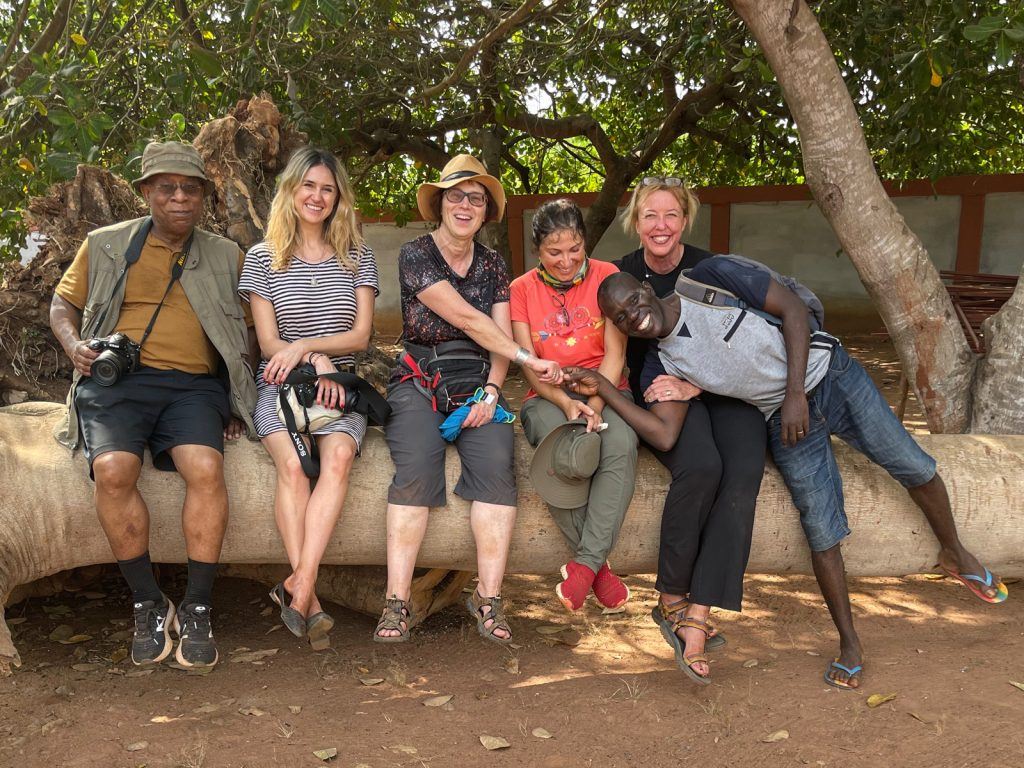
Our 2022 group taking a break outside the Centre for the Arts in Abomey (image by our guides)
That afternoon we started our journey north to Dassa and just before we reached there we had a slight technical hiccup with our van but oddly, in the middle of nowhere, while we waited for the engine to cool a guy rode up to us on his bicycle and tried to sell us ice creams! Where else in the world would that happen!? What a funny surprise!
We finally got the car started and continued to Dassa where we all enjoyed drinks around our hotel pool as we were too full from lunch to eat dinner!
Dankoli Fetish
The next morning we continued north and we made our first stop at the famous Dankoli Fetish, the most prominent voodoo shrine in the world. This place has always been a bit hard for photography due to its forest location and somewhat messy appearance but we stopped anyway as it was a shame to miss a place of such great importance on our trip. We ended up taking some photos of people and also of some blessings taking place at the fetish before we continued our journey north.
The Taneka Spiritual Healers in the Atacora Foothills
We stopped for lunch in Djougou and then continued on to the pretty Taneka villages in the foothills of the Atacora Mountains of northern Benin.
Traditionally a culture from nearby Burkina Faso, the Taneka reside almost exclusively in Benin now. They are known for their spiritual healers, old men who smoke large pipes and either grant wishes or cure ailments.
We walked up a gently inclined hill from our car with a local guide and were shown houses for visiting guests and also the ceremonial place of the village which is only ever used every five years so it was quite overgrown. Wandering through the villages with their pretty round houses and stilted granaries, dotted by large baobab and mango trees is always a wonderful experience here. The first village we visited was home to a sacred baobab which is worshipped for fertility so we made a brief stop there before exploring further.
Our first healer we met was an elderly gent named Danyeri, the healer of fertility and gynaecology.
Like most of the spiritual healers of the Taneka people he wore a simple elephant’s tooth on a piece of leather around his neck and a loin cloth made of animal skin. Smoking his large pipe he kindly allowed us to photograph him at his home.
We went further into the villages and watched with curiosity as women started to cook and grind flour in preparation for their home dinners that night.
We then went and tried to meet King Tanigasawa, the highest king of the Taneka people. Sadly he wasn’t around as he had a matter to attend to in another village but we met his stand in, a lovely man named Sumaru, who kindly answered our questions about Taneka life and allowed us to photograph him in King Tanigasawa’s place.
Some of us bought some souvenirs before we continued our walk around the village. Close to the home of the second healer we met, we watched and photographed a local Taneka woman spinning cotton by hand.
Our second healer was named Namari and his role was that of the Guardian of the Taneka divinity. We spent some time taking photos of him at home before the setting sun forced us to leave and make our way back to the car. On our walk back we spotted an interesting voodoo fetish acting like a scarecrow over a Taneka tobacco field. It was adorned with natural rope and the shell of an African land snail. When we asked we found out that anyone who was caught stealing the tobacco from the fields would become sick! If the fetish itself was stolen then the thief would lose his hearing! Such is the tradition of these peaceful people living in their beautiful villages. As we walked back to our van we were joined by Taneka children who walked with us through the fields. Taneka people also practice scarification and it was already visible in these young children where the boys carried three parallel scars on their cheeks and the girls carried five. It was a fitting farewell to a great afternoon where all of us learned a lot about Taneka culture.
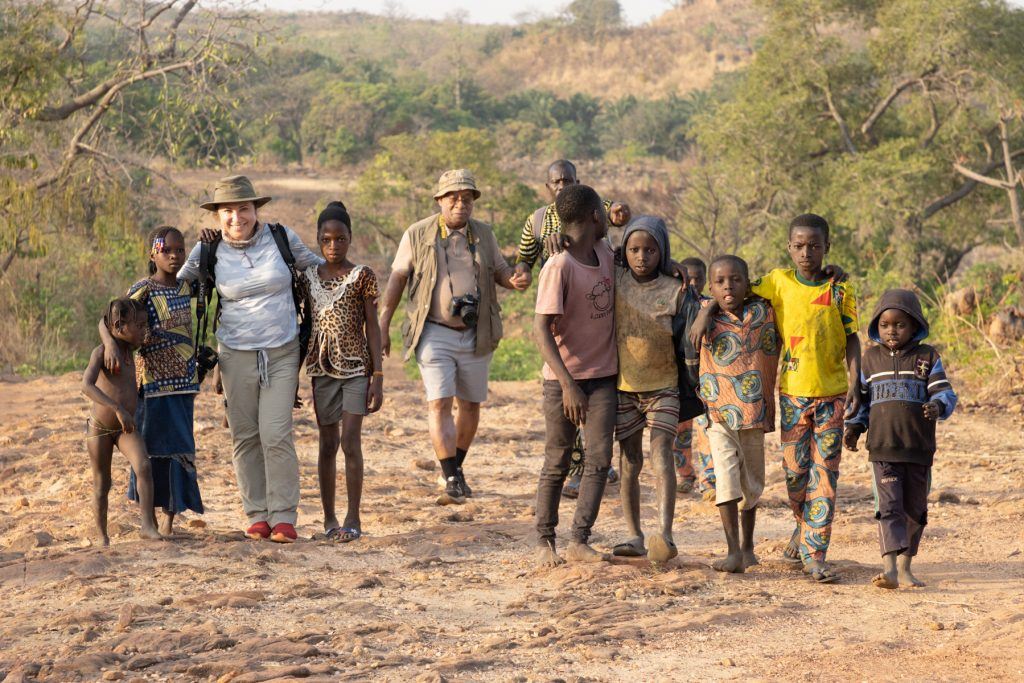
Into the Atacora Mountains
After we bade farewell to the Taneka people we met we drove north again towards the pretty city of Naititingou and our guides stopped the car just short of our hotel! They had seen a young man who was a Somba initiate riding a motorcycle on the city streets. He shyly, yet kindly, allowed us to take some photos of his amazing decorations before we parted company with him and checked into the charismatic Somba Hotel of Naititingou. That night we dined and drank wine under the stars in the hotel courtyard.
Shimo – The Spiritual Separation of Twins in Somba Culture
The next day we drove out into the Atacora Mountains and our first stop was at an ancient traditional Tata, the home of the Somba people, which was estimated to be over 100 years old. It was here we met Flora, who guided us around the Tata and who organised the first of our Somba ceremonies we would see on our tour. The dance was called Shimo. Performed by Somba women, this dance represented the spiritual separation of twins and it involved beautiful dancing and singing to the music of gigantic drums made from gourds. Adorning the legs of each dancer were heavy pieces of metal that acted as bells. We took some portraits of the local women inside and out of the Tata and also some pictures of beautiful scarification in Somba people before we drove further into the mountains to Boukombe where we stopped for lunch.
That afternoon we drove out into Naititingou to buy fuel and we ran into a stunningly tattooed local Fulani woman visiting the market to buy food. We stopped briefly to take her photos but we had a lot to achieve that afternoon so we went out to visit some Tatas on the Togolese border with Benin but sadly it wasn’t easy to take photos. We did chance upon a voodoo ceremony for good health but it was a private ceremony so no photos were allowed. We decided to visit the Somba Tatas belonging to a friend of mine for the rest of the day which was wonderful. It ended up being a great afternoon of photographing traditionally dressed people in beautiful homes, between slow walks through local corn fields with local children. The Atacora really is a beautiful part of Benin and that night we dined on some sumptuous food under the stars.
Traditional Borgu Fulani People from Burkina Faso
Today we met some of the most spectacular tattooed people that I have ever met in West Africa. Arriving at an extremely remote and unnamed village, we were saddened to find virtually no one there. Our guide went off on foot to try and find people for us to photograph and all of us thought he would return to give us directions to the Borgu Fulani village we wanted to visit. Instead people started arriving to us on motorcycles! Talk about taking the mountain to Mohammad!
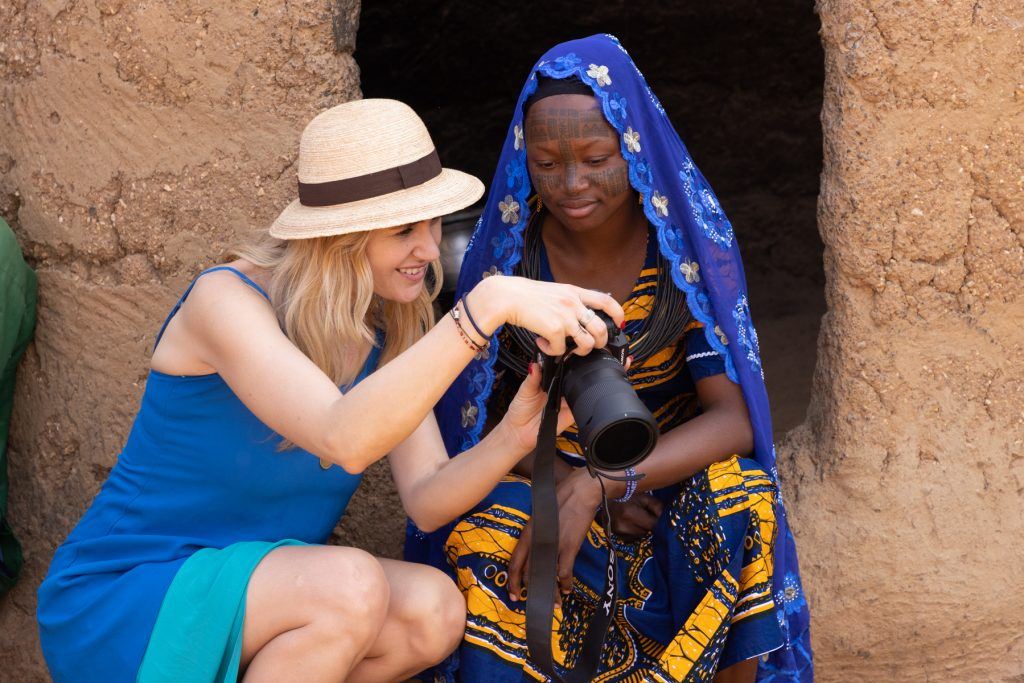
Gosia showing a beautiful Fulani girl her portrait (image by Inger Vandyke)
Gradually more and more people started to arrive on motorbike and all of a sudden we were surrounded by some of the most beautifully tattooed Fulani people we would see on our trip. These people arrived in Benin from Burkina Faso only about three years ago and since then they’ve lived, hidden in the mountains in villages on unmarked trails. We were honoured to meet both men and women with their decorative Borgu facial tattoos. We also met and photographed some beautiful young Fulani girls with their stunning beaded and corded necklaces. What an amazing surprise! We handed over some donations of gifts for appreciation before we returned to Boukombe for lunch. Joining us on the ride back to town was an older Fulani woman with spectacular tattoos all over her body.
Somba Ceremonies – Dikountri (Dance of Women), Dikpantri (Dance of Men) and Tipèinji (Masculine Dance of Strength)
That afternoon we were blessed to attend a large ceremony of Somba people that took place in a few parts – the Dikountri which is danced by Somba women, the Dikpantri danced by Somba men and finally a male dance called Tipèinji which involved cracking a whip and also wrestling, where Somba men could show off their power and ability to protect their families. Performed near a gigantic, hollow Baobab tree these dances were beautiful to see. A few members of our group not only participated in the dances but also in the wrestling matches!
We then walked with the dancers to the village we’d visited the day before to take photos of them at a Tata and also by drone. We also saw our first Somba ceremony on that walk which was a curious collection of domed headstones adorning the head of each grave.
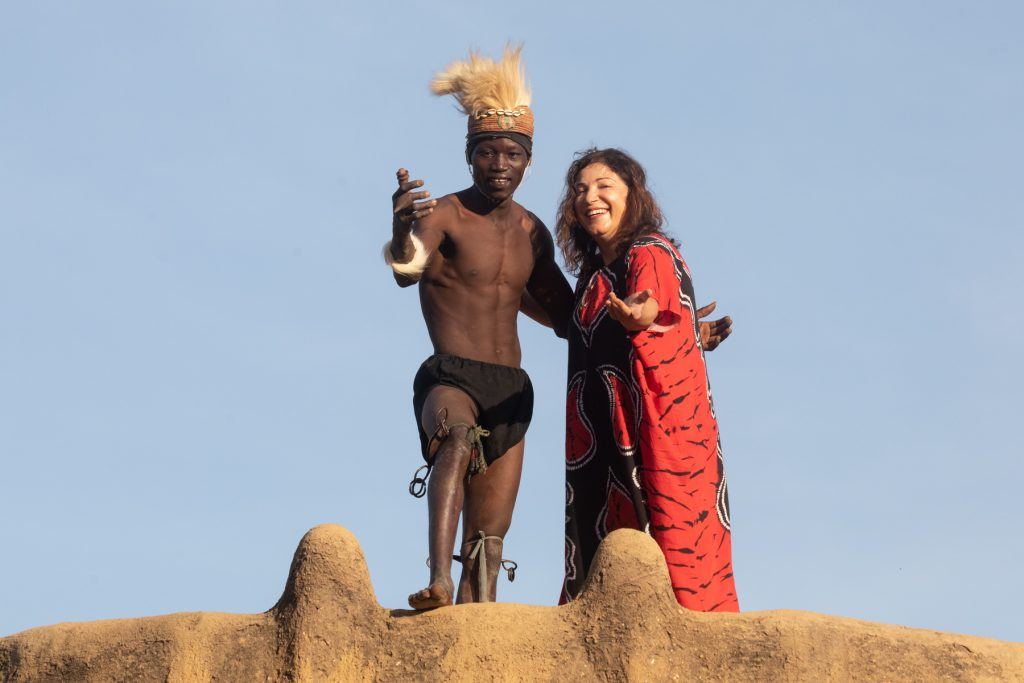
Mojgan with one of the Otamari Dikpantri warriors on top of a local Tata, or Otamari home (image by Inger Vandyke)
As the sun started sinking towards the horizon we were joined by some local Somba children on our walk back to the van so we stopped to take photos of them on the dusty trails, next to one of the Baobabs and also inside the framework of a ruined Tata nearby which provided a great backdrop for images with these lovely children!
Waaba (pronounced Waama) Celebration of the Feminine Divinity
Mid-way through our trip we enjoyed quite a quiet day today leaving Boukombe for Naititingou after a relative sleep in! We drove the easy way back towards Naititingou from Boukombe after a leisurely breakfast. In some places we stopped to fly drones over the Tatas which were beautiful from the air.
We arrived at the Somba Hotel in Naititingou in time for lunch and a siesta.
Late that afternoon we enjoyed another ceremony, this one by a group of beautiful local Waaba women. The Waaba (pronounced Waama) people are a Sub-Saharan ethnic group who reside almost exclusively in Benin. In the past they were known for their beautiful facial scarification but this practice has either been largely modified or abandoned. Still, it was lovely to meet these women and children to witness their pretty dance. At one point we asked a group of dancers to move in front of one of the red walls of the hotel to take photos, a move which produced some almost ‘African Vogue’ style photos of stunning African women in traditional dress.
We still had a little time up our sleeve so some of our group went and visited the Regional Museum of Naititingou which was largely without power but allowed us to learn more about the different architectural styles of the Tata houses, facial scarification patterns and even some traditional medicinal plants of the region. We stopped to do some street photography and buy souvenirs before returning to the hotel to enjoy dinner as a group.
Female Initiation Ceremonial Rites of the Borgu Fulani people
As we continued our search for more beautifully decorated Borgu Fulanis, we ended up visiting a lovely village of settled Fulanis not far from Naititingou. While they were very friendly they weren’t quite photogenic so we started our journey south, stopping in a very remote part of northern Benin where we drove miles on a dirt road and walked around 800 metres into the bush to visit another Borgu Fulani community.
We found more beautiful Fulanis here, but perhaps they weren’t quite as spectacular as the people we’d met further north. Still, we enjoyed some portrait photos with them and the women danced a beautiful initiation dance, their music really sounding like a true song of the desert
Leaving the community we returned to Djougou for lunch before the long drive to Parakou. That night, around the pool of the hotel, we met one of the Batonu horsemen who was going to be riding for us the next day!
Batonu Horsemen of Benin
The next morning we witnessed a ceremony with the lively Batonu horsemen of Benin. Formerly descendent from aristocracy in the Kingdom of Nikki in Nigeria these colourful and athletic horsemen normally only form up once a year to celebrate Gaani in West Africa so meeting them on our tour was quite a wonderful insight into their world. We did some portrait photography with the riders alongside watching them race and dance their horses through the street. We even watched individual riders dismount their horses and dance to the beating drums of ceremony musicians.
After this colourful event concluded we embarked on a long drive south to the town of Cové, close to the border of Benin and Nigeria. We enjoyed an early, but rather noisy due to truck traffic, dinner here outside our hotel!
Island Life on a Remote Lake
We spent the next morning driving to a remote ‘ferry’ stop which acted as the jump off point for the large people pirogues travelling to a remote island of fisherfolk. Situated on a freshwater lake very close to the border of Benin and Nigeria, these island people originally escaped the ravages of slavers.
Unlike Ganvié further east, this island is rarely visited by outsiders but this island of friendly folk are now mostly engaged in fishing and farming. We explored on foot visiting fishermen, the local school, village houses and the island’s coastline which was dotted with hanging fishing nets and hand carved wooden pirogues used by local fishermen to ply the waters of the lake catching fish.
We stopped for a break in the shade while the drone flyers took to the skies. Two of our group members also went out on the lake with a local fisherman for an hour or so.
It is always fascinating to visit such a remote and remarkable place to witness a slice of true African life on the water.
Guéléde
Later that day we attended one of the most spectacular ceremonies of our trip – that of Guéléde, or the feminine divinity of the Yoruba people. Performed by a lovely group of local Mahé people the Guéléde is the only true masked dance of our tour. We arrived early and the dance started late but the time in between gave us a chance to visit a local Zangbeto temple and meet some of the local people before the main dance began.
When it did we were mesmerised. Each masked dancer greeted the officials attending the dance and each of us also. We had some photo sessions with these amazing dancers as they performed and came out to greet us. Some allowed us to have photos with them (even with the odd shock move thrown in!) And others even came out and grabbed us like the crazy stilted dog dancer at the end.
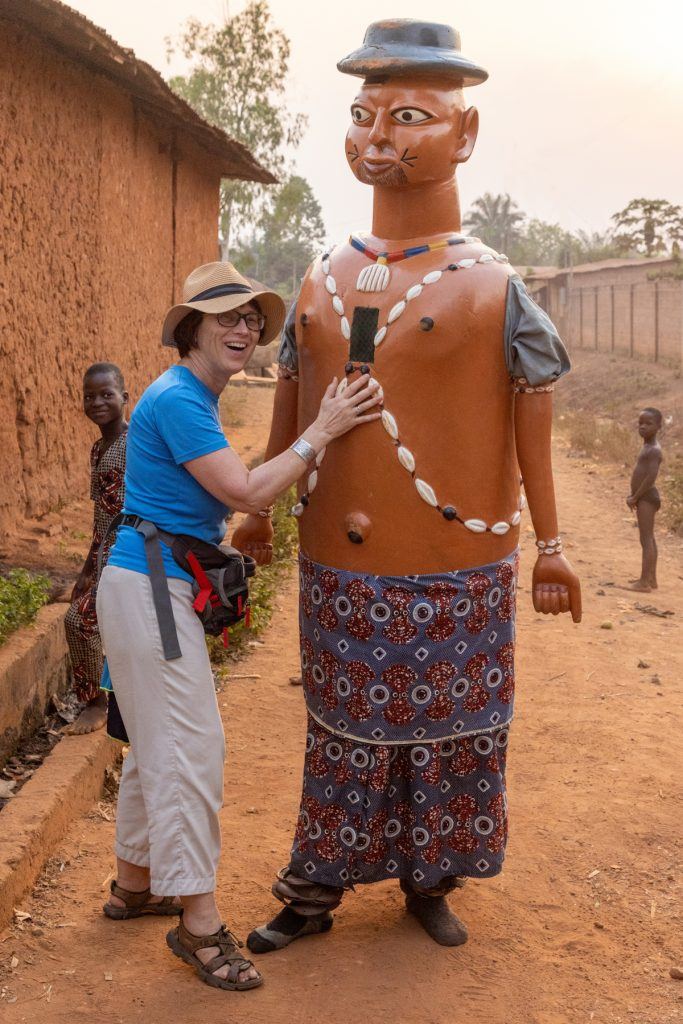
Ksenija with one of the masked dancers of Guélédé (image by Inger Vandyke)
We also met gorgeous Margarita who I met last year at the same event.
This dance left us all laughing and almost in tears for two reasons – it was to be the last dance of our trip and also one of the most spellbinding!
Guélédé Dance from Wild Images on Vimeo.
The Beautiful Scarification and Tattoo Decoration of Holi People
The next morning we left Cové after breakfast and we drove out to visit some villages of local Holi people. Another sub-culture of the larger Yoruba group of Nigeria, Holi people live almost entirely across the southern regions of both countries.
Known for their spectacular facial scarification we stopped to explore these villages on foot and also meet some heavily tattooed elderly women who kindly allowed us to photograph them. I met some of the same people this year as I’d met last year when exploring these villages on foot.
Porto Novo – the Afro-Brazilian Capital of Benin
We left before the heat became too intense to drive to the city of Porto Novo, a former Portuguese colony here in Benin. We spent the afternoon visiting the local mosque which has sometimes been a cathedral, doing street photography there, in the local markets, a rather ghastly fetish market and finally at the major Zangbeto temple of Benin.
Dinner that night was one of pizzas served at a restaurant on a jetty that jutted out onto the waters of Lake Nokue.
Ganvié – the Venice of Africa
After breakfast we left for the second and last ‘floating’ destination in Benin, the fabulous Ganvié, or the ‘Venice of Africa’ as it is often known.
Established when the king of the Tofinu people took his people out on the waters of Lake Nokué to escape slavers, the stilted village of Ganvié is now home to around 80,000 people living a subsistence lifestyle on one of Benin’s largest coastal lakes.
Surviving in a sea of brackish water by fishing these and the saltier seas towards the coast, the local people of Ganvié are known for their beautiful body tattoos and self imposed isolation on the lake.
We arrived at the large ‘ferry stop’ of commuter pirogues used to transport people and goods out to Ganvié. The drone flyers of our group were in heaven here as we all flew over the many hundreds of pirogues, fish farms and the local fish market. I went off on foot to look through the fish market with one of our guests but the women were reluctant to have their photos taken which was a shame.
We packed up our large pirogue and headed out to the floating village on the water, stopping to photograph fishermen casting their nets in the water! Stopping with one of them, we also bought a basket of fresh fish to take with us to our guest house.
We arrived at our basic lodge and checked in to enjoy a lunch of freshly caught lake fish cooked by the lodge owners.
Ganvié Golden Hour from Wild Images on Vimeo.
Later that afternoon we took a large pirogue out into the village to do some ‘street’ photography of the people living there. Despite a few frustrations with people reluctant to have their photos taken the pirogue cruise was still a great glimpse into the world of Ganvié and its residents. We reached our guest house by sunset in time to watch the last of Ganvié’s rush hour in the golden light and watch the world go by over a few cold beers. So many people choose to go to Ganvié for just a few hours during the day but if you can handle the basic guest house, an overnight is really special, just to be there when the light is beautiful.
Ouidah
We had an early start from Ganvié in order to make it to Cotonou to have our PCR tests done. The pirogue ride in the early morning gave us a chance to capture some nice fishing boats in the morning before we arrived to face the traffic of rush hour in Cotonou.
School Desk Project Visit
Still, we managed to get our PCR tests done in good time and from Cotonou we drove out to visit one of the schools who benefitted from our 2021 school desk fundraiser. We first met with the head master of the school and then we were shown around to one of the classes with students in their French class. It was great to meet these lovely young people and see them sitting at shining, well-made new desks. Each could seat two students and there was even a place underneath each table to store residual school materials. They were very well done and appreciated by all!
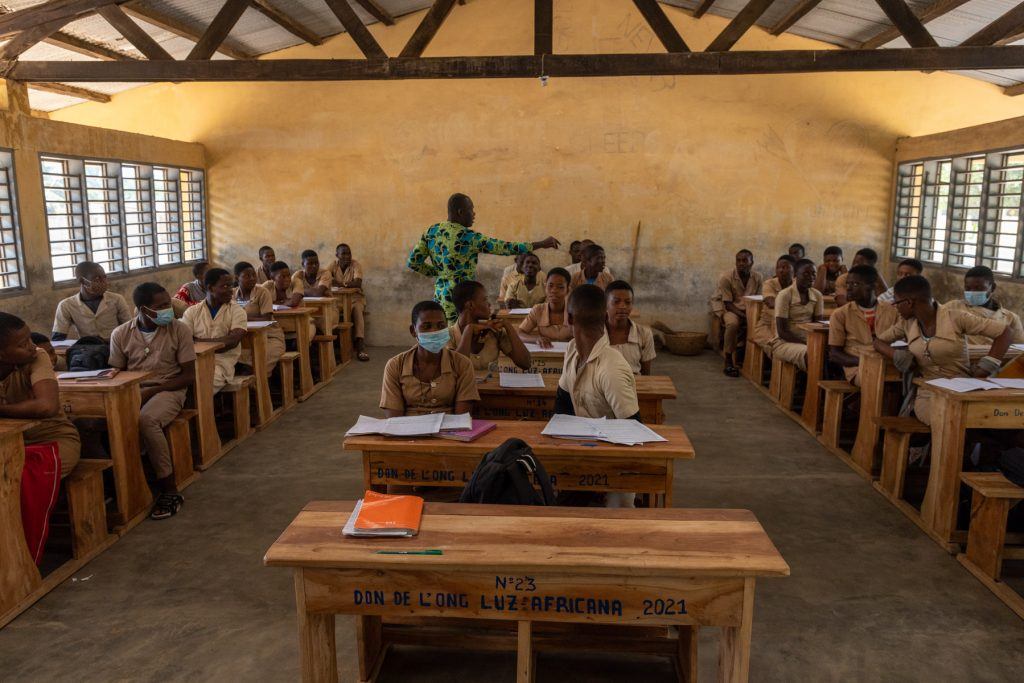
The Wild Images desk project at a school in western Benin (image by Inger Vandyke)
Continuing on from the school we drove back to the coast to spend the rest of the day exploring historical Ouidah with its monuments to slavery and former colonial houses from the Afro-Brazilian era.
The Python Temple of Ouidah
Our first stop was the curiously wonderful python temple with its resident collection of Ball’s (or Royal) Pythons and lovely snake handlers. Pythons are revered in voodoo culture and it is forbidden to hurt or kill one. The story goest that these pythons are allowed out each night to slither their way around Ouidah visiting people. If one shows up at your house it is considered as very good luck and the occupant must take care of it until they can take it back to the temple the following day. It is an act that is so cherished by Ouidah’s residents that even the Catholic cathedral across the street will take care of any visiting pythons and return them the next day if they are lucky enough to be visited.
Fondation Zinsou – Exploring Afro-Brazilian Art and Architecture
From there we all embarked on a museum and souvenir buying blitz that started in the Python temple and the nearby streets and ended up at Ouidah’s beautiful Fondation Zinsou building turned museum plus a nearby arts museum and gallery in a fantastic old Afro-Brazilian house that had been cared for and turned into a small museum and cafe. What a great morning! We bought some lovely things and thoroughly enjoyed wondering through this artistic centre of Benin!
A Dark History of Slavery
Sadly many of the former slavery monuments were under wraps while the city undergoes a civil transformation that involved lots of roadworks, but we still managed to visit the original holding area of slaves and also a mass grave for the poor souls who never made it to the start of the journey over the Atlantic.
Coastal Fishing Communities of Benin
We decided to go off on a drive along the coast to explore some of Benin’s (former) fishing villages, however when we arrived we were all saddened to find out that many of them were being destroyed in China’s scorched earth policy here in Africa. Most of the villages had been demolished and some remnants were even on fire when we went. We took photos and flew drones over the sites that I had visited just a year before when all of these communities were intact.
While it was a lovely afternoon on the beach, the destruction really became evident when we met a local Ghanaian fisherman, David, who told us about the demise of his village. He showed us the place where his father was buried. An elder who was important in the fishing community at Ouidah, they had managed to save his grave and the voodoo shrine adjacent to it. We went over to take photos and met an old man who was in tears looking at the destruction of lives brought on by ‘development’. It was a little harrowing to see such terrible destruction of these livelihoods, after decades, or even centuries, living as a small fishing community in coastal Benin. It is these fishing villages that gave Benin its timeless allure, not flashy tourists lacking in soul. My hope was that these people may find some home further along the coast closer to Grand Popo where many communities are intact, at least for now. It was so sad to see this happening in such a beautiful part of Benin.
Dinner of our last night of the trip was on the beach at our hotel, listening to the crashing surf and being cooled by a gentle ocean breeze.
What a fantastic journey through this fascinating corner of West Africa. The tour surpassed all of our expectations for photography and learning. We saw so many things that are rarely seen by anyone outside of Africa and none of us really wanted it to end!







































































































































































